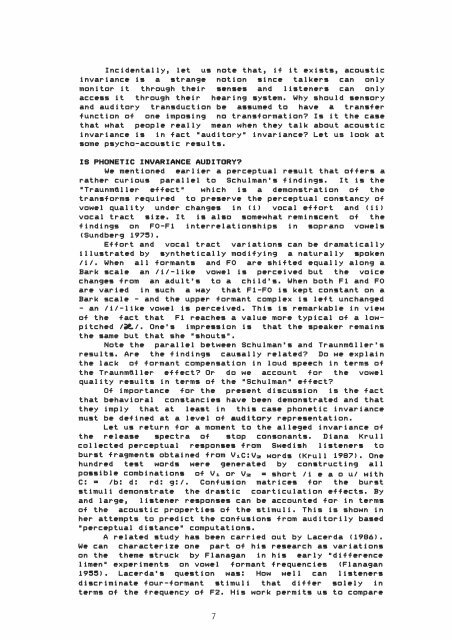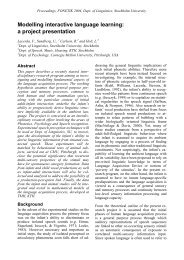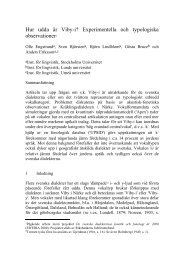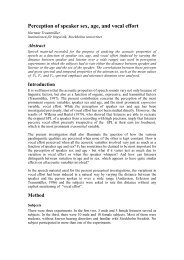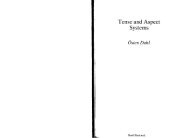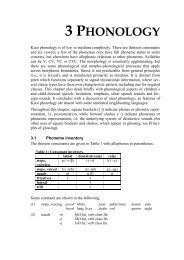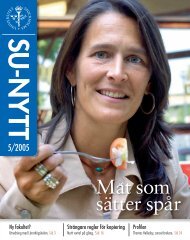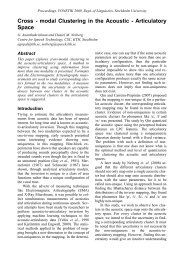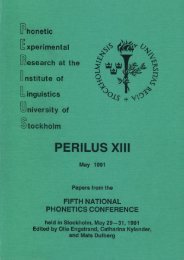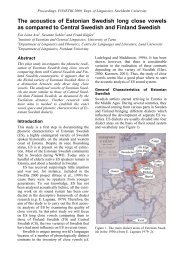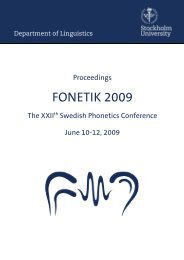perilus v - Stockholms universitet
perilus v - Stockholms universitet
perilus v - Stockholms universitet
Create successful ePaper yourself
Turn your PDF publications into a flip-book with our unique Google optimized e-Paper software.
Inc identally, let us note that, if it ex ists, acoust ic<br />
invar iance is a strange not ion since talkers can only<br />
mon itor it through their senses and listeners can only<br />
access it through the ir hear ing system. Why should sensory<br />
and aud itory transduct ion be assumed to have a transfer<br />
funct ion of one impos ing no transformat ion? Is it the case<br />
that what people really mean when they talk about acoustic<br />
invar iance is in fact Uauditory· invar iance? Let us look at<br />
some psycho-acoust ic results.<br />
IS PHONETIC INVARIANCE AUDITORY?<br />
We ment ioned earl ier a perceptual result that offers a<br />
rather cur ious parallel to Schulman's find ings. It is the<br />
uTraunmCller effect· wh ich is a demonstrat ion of the<br />
transforms requ ired to preserve the perceptual constancy of<br />
vowel quality under changes in (i) vocal effort and (i i)<br />
vocal tract size. It is also somewhat rem inscent of the<br />
find ings on FO-F1 interrelat ionsh ips in soprano vowels<br />
(Sundberg 197).<br />
Effort and vocal tract var iat ions can be dramat ically<br />
illustrated by synthetically modify ing a naturally spoken<br />
IiI. When all formants and FO are sh ifted equally along a<br />
Bark scale an IiI-l ike vowel is perce ived but the voice<br />
changes from an adult's to a ch ild's. When both F1 and FO<br />
are var ied in such a way that F1-FO is kept constant on a<br />
Bark scale - and the upper formant complex is left unchanged<br />
- an IiI-l ike vowel is perceived. Th is is remarkable in view<br />
of the fact that F1 reaches a value more typical of a lowpitched<br />
I /. One's impress ion is that the speaker rema ins<br />
the same but that she ·shouts·.<br />
Note the parallel between Schulman's and TraunmCller's<br />
results. Are the find ings causally related? Do we expla in<br />
the lack of formant compensat ion in loud speech in terms of<br />
the TraunmCller effect? Or do we account for the vowel<br />
qual ity results in terms of the ·Schulmanu effect?<br />
Of importance for the present discuss ion is the fact<br />
that behav ioral constanc ies have been demonstrated and that<br />
they imply that at least in this case phonet iC invar iance<br />
must be def ined at a level of auditory representat ion.<br />
Let us return for a moment to the alleged invar iance of<br />
the release spectra of stop consonants. Diana Krull<br />
collected perceptual responses from Swed ish listeners to<br />
burst fragments obtained from V1C:VZ words (Krull 1987). One<br />
hundred test words were generated by constructing all<br />
poss ible combinat ions of V1 or Vz = short Ii e a 0 ul with<br />
C: · Ib: d: rd: g:/. Confus ion matr ices for the burst<br />
st imul i demonstrate the drastic coart iculat ion effects. By<br />
and large, listener responses can be accounted for in terms<br />
of the acoust ic propert ies of the st imul i. Th is is shown in<br />
her attempts to predict the confus ions from aud itor ily based<br />
·perceptual distance- computat ions.<br />
A related study has been carr ied out by Lacerda (1986).<br />
W. can characterize one part of his research as var ia tions<br />
on the theme struck by Flanagan in his .arly -difference<br />
limen· exper iments on vowel formant frequenc ies (Flanagan<br />
19). Lac.rda's quest ion was: How well can listeners<br />
discr im inate four-formant st imuli that differ solely in<br />
terms of the frequency of F2. His work perm its us to compare<br />
7


